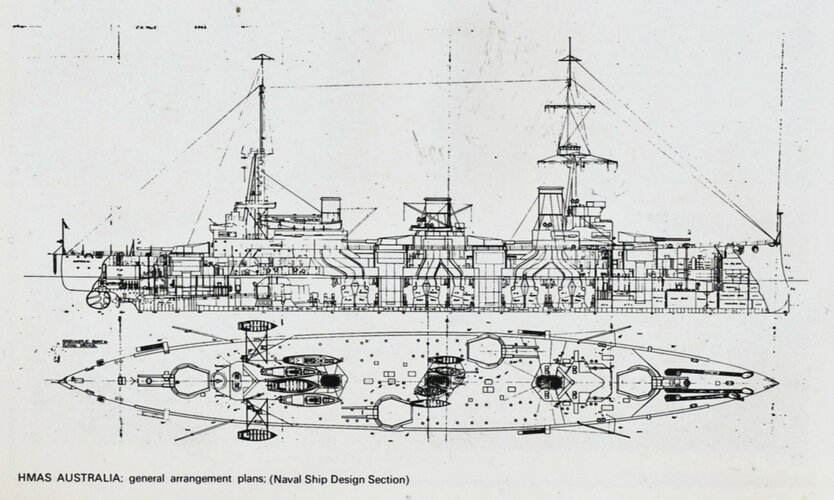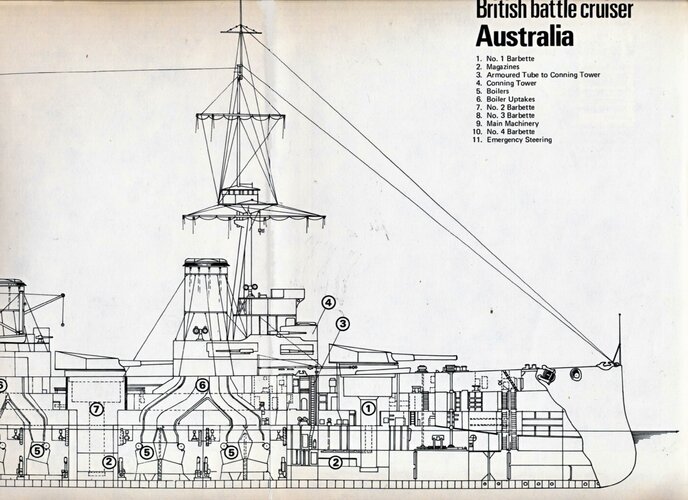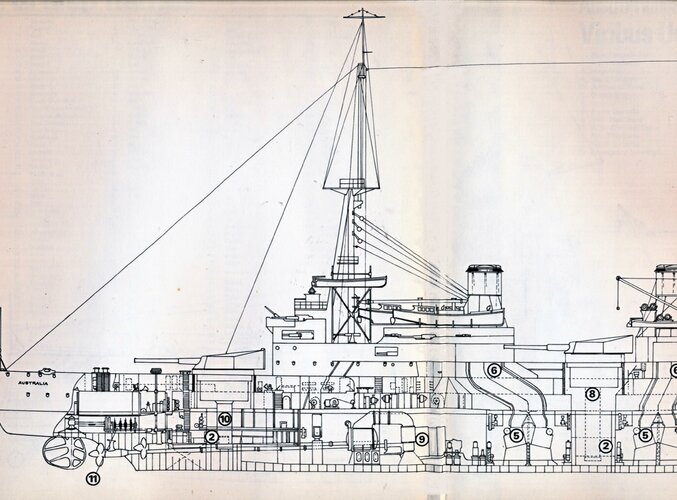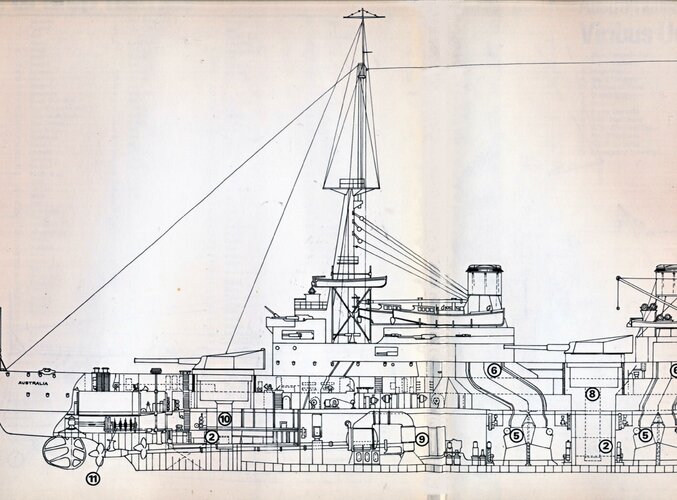Owens Z
quaerimus scientiam
- Joined
- 6 October 2023
- Messages
- 256
- Reaction score
- 328
Although I have not travelled to the Southern Hemisphere, I have followed with interest the continuing arguments in Australia and elsewhere about the battlecruiser HMAS Australia, that she should not have been scuttled off Sydney in 1924 according to terms of the Washington Naval Treaty, but instead could have usefully stayed in service. The 2004 article "A Loss More Symbolic Than Material?" cited in the first post of this interesting thread gives an overview of the issues. Neither the article nor the posts in this thread quite say so, but of course the reason why this particular warship has been argued over is because during the Treaty's negotiations in February 1922, an Australian could have stood up and factually stated "in twenty years my country will be fighting for its life, with the city of Darwin in flames from enemy bombing, and we'll need every ship we can get". But while entirely truthful, such prescience seems implausible. And it appears from history that there wasn't a will in the Australian government or navy in the early 1920's to retain the obsolescent battlecruiser.
I don't think the lawyerly argument that this ship was now "really an armoured cruiser" would have passed the laugh test during the Treaty negotiations. More tenable is that Australia, had the will been present, could have presented itself as an independent country from the UK, and declared that the UK's signature on the Treaty didn't affect Australia's separate navy, founded in 1901 (with some added effort being made to reduce the large percentage of the ship's crew who were British). HMAS Australia would then not have been subject to the Treaty, just like the existing dreadnought capital ships of Argentina, Brazil, Chile, Spain, Turkey, and the USSR were not.
I judge that a counterfactually surviving HMAS Australia was unlikely to have had a comprehensive reconstruction between the wars like, for example, Italy and Japan expensively gave their older capital ships. Instead it would have had something like the refits that Argentina, Brazil, Chile, Spain, Turkey, and the USSR gave their dreadnoughts: i.e. modest at best. In 1941-42 the ship would probably be unable to approach her 26-knot First World War full speed. Her main battery's 16-degree elevation would have been usefully increased, and had Australia foresightedly obtained and warehoused the Royal Navy's stocks of 12" Mark VIIa Greenboy shells, and spare barrels, at little expense when the RN put the 12"/45 Mark X gun out of service in the early 1920's, there would have remained a plentiful supply of ammunition for the ship (stocks of USN AP Mark 15s might have been made available had Greenboy deterioration in storage become a real problem). Her country has plenty of coal, for fuel. The battlecruiser would enter WW2 with an antiaircraft battery that was thought adequate at the time; i.e. inadequate. But had she survived 1942's savage fighting, the AA battery would have been greatly strengthened with US-supplied 20mm and 40mm cannon. And her probable lack of radar in 1942 would have been corrected with US equipment.
Assuming she was still in service at the start of WW2, how would HMAS Australia have contributed to the country's war effort, do you think? I discuss in another thread how a counterfactually surviving HMS Tiger would have seen worthwhile service for Britain during WW2. Tiger, about three years later in conception than the Indefatigable class of which Australia was a part, was a substantially larger and faster ship, with greater firepower, and she endured the German shells that exploded Indefatigable at Jutland. But in desperate times, every little bit can help. How decisive would the obsolete HMAS Australia have been? No matter how poor the crew's morale, a Royal Australian Navy warship, in her country's hour of need, would be unlikely to flee along with the British Eastern Fleet to Kenya, or escape to California. But the fighting old battlecruiser would not be able to match Japanese capital ships (or deal with airpower) and would probably have been sunk during the war, maybe with as heavy a loss of life as Indefatigable suffered, for a country with limited manpower.
I don't think the lawyerly argument that this ship was now "really an armoured cruiser" would have passed the laugh test during the Treaty negotiations. More tenable is that Australia, had the will been present, could have presented itself as an independent country from the UK, and declared that the UK's signature on the Treaty didn't affect Australia's separate navy, founded in 1901 (with some added effort being made to reduce the large percentage of the ship's crew who were British). HMAS Australia would then not have been subject to the Treaty, just like the existing dreadnought capital ships of Argentina, Brazil, Chile, Spain, Turkey, and the USSR were not.
I judge that a counterfactually surviving HMAS Australia was unlikely to have had a comprehensive reconstruction between the wars like, for example, Italy and Japan expensively gave their older capital ships. Instead it would have had something like the refits that Argentina, Brazil, Chile, Spain, Turkey, and the USSR gave their dreadnoughts: i.e. modest at best. In 1941-42 the ship would probably be unable to approach her 26-knot First World War full speed. Her main battery's 16-degree elevation would have been usefully increased, and had Australia foresightedly obtained and warehoused the Royal Navy's stocks of 12" Mark VIIa Greenboy shells, and spare barrels, at little expense when the RN put the 12"/45 Mark X gun out of service in the early 1920's, there would have remained a plentiful supply of ammunition for the ship (stocks of USN AP Mark 15s might have been made available had Greenboy deterioration in storage become a real problem). Her country has plenty of coal, for fuel. The battlecruiser would enter WW2 with an antiaircraft battery that was thought adequate at the time; i.e. inadequate. But had she survived 1942's savage fighting, the AA battery would have been greatly strengthened with US-supplied 20mm and 40mm cannon. And her probable lack of radar in 1942 would have been corrected with US equipment.
Assuming she was still in service at the start of WW2, how would HMAS Australia have contributed to the country's war effort, do you think? I discuss in another thread how a counterfactually surviving HMS Tiger would have seen worthwhile service for Britain during WW2. Tiger, about three years later in conception than the Indefatigable class of which Australia was a part, was a substantially larger and faster ship, with greater firepower, and she endured the German shells that exploded Indefatigable at Jutland. But in desperate times, every little bit can help. How decisive would the obsolete HMAS Australia have been? No matter how poor the crew's morale, a Royal Australian Navy warship, in her country's hour of need, would be unlikely to flee along with the British Eastern Fleet to Kenya, or escape to California. But the fighting old battlecruiser would not be able to match Japanese capital ships (or deal with airpower) and would probably have been sunk during the war, maybe with as heavy a loss of life as Indefatigable suffered, for a country with limited manpower.






